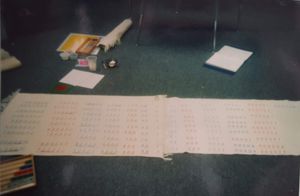Decimals Presentation of Decimal Symbols Lesson 6
From wikisori
Contents
Age
9-12
Materials
- Bank game cards from units to millions
- Decimal numbers from tenths to millionths
- Decimal board
Preparation
Students should have had the Decimal Lessons 1-5 (We are moving from the concrete toward the abstract).
Presentation
These lessons are providing an opportunity for the student to be comfortable with decimal place values. These experiences are assisting the student to move toward abstraction.
- 1. Lay out the cards for units 1 to 9 in the center of the floor. Ask the student(s), "What is to the left of unts?" (tens). Place the column of ten numbers (10-90) to the left of the units. continue in the same manner for the hundreds, thousands, and so on to the millions.
- 2. Say, "All of these are whole numbers; but, as we've seen before, there are numbers that are smaller than whole numbers: decimals." Take the decimal cards out.
- 3. Ask, "What is immediately to the right of the units?" (tenths). Place the row of tenths numerals from 0.1 to 0.9, naming them as you go (Note that these are blue, like the disks and like the tens.)
- 4. Ask, "What is immediately to the right of the tenths?" (hundredths). Place the hundredths numerals form 0.01 to 0.09, naming them as you go (Note the red color, like the disks and like hundreds.)
- 5. Continue for thousandths, ten-thousandths, hundred-thousandths, and millionths.
- 6. Show the corresponding numerals on each column of the decimal board.
- 7. Point out to the child that as we go toward the left with these numerals, they become larger; and as we go toward the right, the numerals become smaller.
Point out also that, with the whole number cards, longer numerals mean larger quantities; but with the decimal cards, longer numerals mean smaller quantities.
Control Of Error
Teacher guided.
Points Of Interest
Participating with the new knowledge helps move the concrete experiences toward abstract thinking
Purpose
- To make a visual, auditory and kinesthetic impression upon the child on how whole numbers are divided into smaller units-decimals.
Variation
Students can recreate the symbols in these lessons in their Math journals.
Handouts/Attachment

